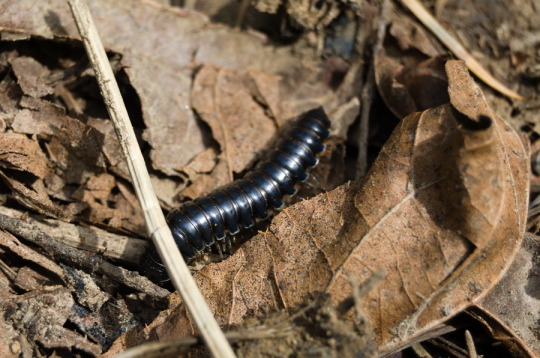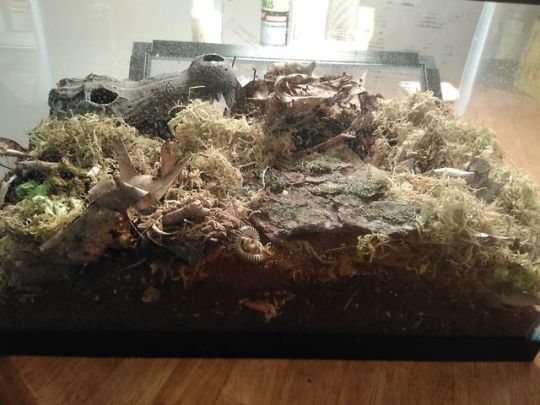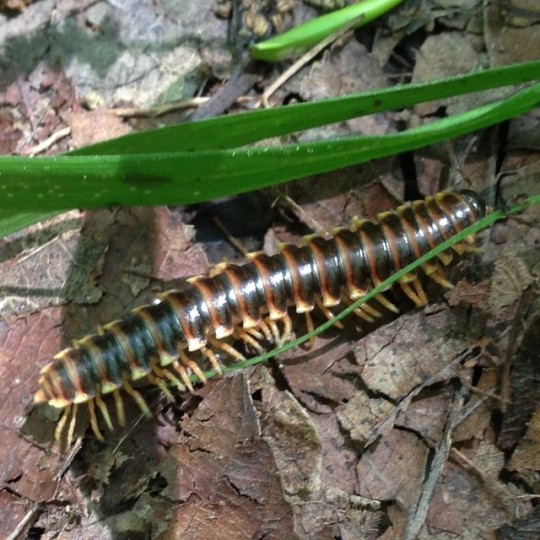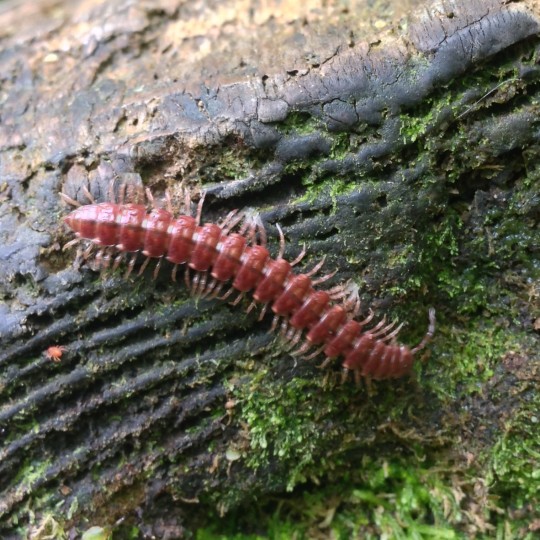#Order: Polydesmida
Explore tagged Tumblr posts
Text

Range: Southeast Alaska to California
#poll#Class: Diplopoda#Order: Polydesmida#Family: Xystodesmidae#Genus: Harpaphe#Harpaphe Haydeniana#Range: Nearctic#bug tw
26 notes
·
View notes
Photo

@flammableengineering submitted: Found this little guy, please ID!
Location: Portland, OR
A long pal :) It’s a flat-backed millipede in the order Polydesmida, but I’m afraid I can’t ID this one to a species level.
94 notes
·
View notes
Text
Round 2 - Arthropoda - Diplopoda




(Sources - 1, 2, 3, 4)
Animals in the class Diplopoda are commonly called “Millipedes.” They comprise the orders Glomeridesmida (“Slug Millipedes”), Glomerida (“Northern Pill Millipedes”), Sphaerotheriida (“Giant Pill Millipedes”), Platydesmida (“Flat Millipedes”), Polyzoniida (“Camphor Millipedes”), Siphonocryptida, Siphonophorida, Julida, Spirobolida, Spirostreptida, Callipodida, Chordeumatida (“Sausage Millipedes”), Stemmiulida, Siphoniulida, Polydesmida, and Polyxenida (“Bristly Millipedes”).
Millipedes are detritivores, eating decaying leaves and other dead plant matter, making them important for cycling soil. Some species eat fungi or drink plant sap. Most species protect themselves with various chemical secretions, but they will also coil into a ball to protect their legs and vital areas when threatened. Polyxenids lack poison and a hard exoskeleton, so their defense involves barbed hairs that detach and stick to the mouths of predators.
Millipede heads are generally round and flattened, consisting of a pair of mandibles, a plate-like “jaw lip” called a gnathochilarium, a pair of small sensory antennae, and simple compound eyes. Some species have secondarily lost these eyes. Many species also have a pair of sensory organs called the T��mösváry organs at the bases of their antennae, which may measure humidity and/or light levels. Millipede bodies may be flattened or cylindrical, and they can be anywhere from 2 mm (1⁄16 in) to 35 cm (14 in) in length, and have from 11 to over 300 body segments. The segment behind their head is called a collum and is legless. The second, third, and fourth body segments are called haplosegments, and each have a single pair of legs on their underside. The remaining segments are called diplosegments and have two pairs of legs each. In some millipedes, the last few segments may be legless. The final segment is called the telson. It is always legless, and contains the anus. Some millipedes (those in the superorder Nematophora) have spinnerets as well, creating silk chambers in which to molt or lay their eggs. Though their name means “thousand feet”, only one species of centipede, Eumillipes persephone, has over 1,000 feet.
Millipede reproductive behavior is diverse. Bristle millipedes reproduce similarly to centipedes: depositing spermatophores onto webs they secrete, which are later picked up by females. Other millipedes have direct reproduction, meeting up to mate. Courtship may involve tapping antennae, the male running along the back of the female, offering gifts of edible glandular secretions, or even “chirping”. Males have one or two pairs of modified legs called gonopods which are used to transfer sperm to the female during copulation. A few species are parthenogenetic, having few, if any, males. Most species simply deposit their eggs on the ground, but some construct nests of dried feces or silk. In most species, the female abandons the eggs after they are laid, but some species do provide parental care for their eggs and young. Young millipedes usually hatch after a few weeks, bearing typically only three pairs of legs. Their development is anamorphic: adding on segments and legs with each moult. Some species can live up to 10 years.
Millipedes first appeared in the Silurian period. The most famous extinct millipedes, the genus Arthropleura of the Carboniferous, grew up to 2.5 metres (8 ft 2 in) long, making them some of the largest arthropods ever known.

Propaganda under the cut:
What is the difference between centipedes and millipedes? Centipedes are if a tiger was small, long, and venomous. Millipedes are if a cow was small, long, and poisonous. Hope that helps.
Mentioned above, Eumillipes persephone can have over 1,300 legs!
Millipedes have a vast array of chemical poisons to ward off predators, varying between genera. Polydesmid Millipedes produce Hydrogen cyanide. Motyxia species not only produce cyanide, but are also bioluminescent.
Despite their chemical defenses, many species prey on millipedes, some even benefiting from the poisons. Some poison dart frogs eat millipedes, converting their toxins into their own poison. Some lemurs use millipedes to self-medicate against parasites, or just to get high!
Many species have formed symbiotic relationships with millipedes. Some millipedes live only in ant colonies, while many mites use millipedes for transport to new areas. The Moss Millipede (Psammodesmus bryophorus) grows multiple species of moss on its back for camouflage, subsequently aiding the moss in dispersal.
42 notes
·
View notes
Note
do you know who this lil guy is?

I can't ID it without a location, but it looks like it might be a Flat-backed Millipede (Order Polydesmida) of some kind. Could be Dicellarius if you're in the southeast US.
7 notes
·
View notes
Photo



im actually not sure what this guy is. im assuming something in the order Order Polydesmida. so so cute though! photos by me
103 notes
·
View notes
Text


Pale Flat-backed Millipede
Unidentified, order Polydesmida
24/03/23 - NSW, Dapto
#Polydesmida#unidentified#Flat-backed Millipedes#Helminthomorpha#Worm-like Millipedes#Diplopoda#Millipedes#Myriapoda#Myriapods#invertebrates#invertblr#Arthropods#Arthropoda#bugs tw#insects#insect#insecta#insectblr#insects tw#bugs#bugblr#bug#entomology
27 notes
·
View notes
Text

Kentucky flat millipede (Apheloria virginiensis), family Xystodesmidae, order polydesmida, North Carolina
3 notes
·
View notes
Text





Dalodesmidae (Keeled millipedes) is a family of millipedes in the order Polydesmida, containing at least 250 species found in the Southern Hemisphere. Многосвязы Polydesmida — отряд двупарноногих многоножек, включая всех многоножек, которые, как сообщается, производят цианистый водород (HCN).
Полидесмиды растут и развиваются посредством серии линьки, добавляя сегменты до тех пор, пока они не достигнут фиксированного числа на взрослой стадии, которое обычно одинаково для данного пола у данного вида, после чего линька и добавление сегментов и ног прекращаются. Этот способ развития, известный как телоанаморфоза, отличает этот отряд от большинства других отрядов многоножек, которые обычно продолжают линять во взрослом возрасте.
Phylum:Arthropoda
Class:Diplopoda
Order:Polydesmida
Family:Dalodesmidae
Species of Dalodesmidae are found in Australia (over 100 species), Madagascar, New Caledonia, New Zealand, South Africa, and southern South America (Chile and southern Brazil). Кольца тела далодесмид имеют довольно пунктированную или скульптурную спинную поверхность, а их ноги у большинства Polydesmida всегда выглядят немного длинными.
47/22 Northcross dr, Auckland NZ
7PJC+M45 Auckland
-36.7183720, 174.7203656
наземные насекомые членистоногие беспозвоночные многоножки
1 note
·
View note
Text
seems to be some kind of flat-backed millipede, polydesmus sp i believe?
y’all i just found the cutest thing i ever did see

losing my fucking mind over this guy
47 notes
·
View notes
Photo

I’ve been making a little vivarium as a fun thing to do and it’s finally complete :0
Size: 5.5 gal zilla critter cage
Substrate: EcoEarth coconut fiber, unscented aspen shavings, dried leaf litter, miscellaneous twigs/bark, and sphagnum moss. Occasionally supplemented with fresh fruit and vegetables, and crushed egg shells for calcium.
Moisture: misted with tap water once per day
Residents:
1 Giant North American Millipede (Narceus americanus)
1 Bumblebee millipede (Anadenobolus monilicornis)
1 Oregon millipede (Tylobolus uncigerus)
1 Eastern Hercules beetle larvae (Dynastes tityus)
3 earthworms
Approximately 20 Greenhouse millipedes (Oxidus gracilis)
Various isopods (pill and sow bugs) (approx 1-2 dozen)
1 flat-back millipede (species unknown, order Polydesmida)
This is what I’m starting out with, the species with sufficient populations might start breeding if they like their home enough :0 But I’m keeping an eye on it to make sure it doesn’t get overrun. I hope the beetle grub grows up big and strong too
16 notes
·
View notes
Photo

I had no awareness of flat-backed millipedes until a few years ago when this critter was spotted hanging out in my organic kitchen garden. I believe the species is Pleuroloma flavipes.

Then, on one of my trips to Oregon I got to see this pretty brick-red one making its living in a forest (who wouldn’t!) that’s been tentatively identified as Nearctodesmus insulanus.

Farther south I spotted this one getting its many feet muddy in the Monteverde Cloud Forest Reserve in Costa Rica. Using iNaturalist’s computer vision program I’m IDing this one for now as Nyssodesmus python. What a great name, right?
Flat-backed millipedes are in the Order Polydesmida. With around 3,500 species it is the largest order of millipedes (Class Diplopoda.) They produce hydrogen cyanide (not sure if they all do) and many have bright coloration to warn predators that they’re armed. They don’t have any eyes, so are unfortunately probably not aware of how pretty they are. The group’s name comes from the widened lateral keels called paranota that some, but not all species have.
For more on these animals check out the cool website I found while researching this post. It contains this paragraph which makes me think all my IDs should remain tentative until a real expert looks at them:
“Polydesmida are poor dispersers under natural conditions and seem to be very good at evolving new species. As a result, many polydesmidan species have small geographical ranges (100‒1000 square kilometres). Some Polydesmida are only known to occur at a single locality, such as a particular mountain. Polydesmidan genera are also good at forming distribution mosaics, in which each species occupies its own patch on the map and overlaps very little (or not at all) with other species in the same genus.”
5 notes
·
View notes
Text
List of Families within Polydesmida I’ve covered (each link leads to the tags for each family):
Xystodesmidae
1 note
·
View note
Photo

@owlbear33 submitted: first have this pair of Orange Tips (Anthocharis cardamines) my mum found sitting on some flowers on 12/5/22
second have this tiny millipede I found sifting compost in the garden on the 18th, it was tiny maybe 2 cm long at most, and moving with some speed, though a lot slower than the long wriggly centapedes I sometimes find, I'd love to have more of an ID than tiny millipede, I'm in mid wales (uk) if that helps

Cute friends! Orange tips are adorable. I can tell you the millipede is a flat-backed millipede in the order Polydesmida, and maybe one in the genus Polydesmus, but I couldn’t get much more specific based on this photo!
54 notes
·
View notes
Text
✨Arthropoda Orders✨
Insecta and Arachnida orders link to other nav posts, everything else is a direct tag link!
(☞︎☞︎☞︎= Families)
arthropoda tag
Class Insecta
🪳 Blattodea
🐞 Coleoptera
🪲 Hemiptera
🐝 Hymenoptera
🦋 Lepitoptera
🌱 Mantodea
🦗 Orthoptera
🪰 Diptera
🐟 Zygentoma
Class Aracnida
🕸 Araneae
🕷 Opiliones
Class Diplopoda
🪱 Spirostreptida
☞︎☞☞︎ spirostreptidae
🐛 Polydesmida
☞︎☞︎☞︎ xystodesmidae
1 note
·
View note
Text

Well hey if you insist!!!
So far I have five, although two of them are more concepts than actual characters.
1: A human girl who's cursed to turn into a scolipede basically at random and, while in that form, lacks all the confidence and aggression scolipedes normally have but has exactly zero impulse control so. She's this big bughorse that can't help but eat everything offered, get fucked at every chance, ect ect. Her name's Poly, short for Polydesmida, the largest order of millipedes!
2: An ambitious trainer who uses pheromones to better control her bug pokemon but, as a result, has to deal w side effect behaviors like her combees storing all their honey in her and whatnot
3: A Tapu Fini who tries to use her water to cleanse all that troubles those around her. Sadly, she doesn't understand how emotions work and so her reaction to someone being sad is to inflate them w her magic water
4: A Deoxys that's pretty much just bumming around, curious about life on earth and eager to learn, especially things related to biology. Usually that means collecting dna from, yknow, fuckin, but also 'hmm, digestion is strange. i must investigate.' and then stuffing themselves/someone else as much as possible, or altering someone's dna to see what happens, or whatever else strikes this alien god's curiosity. I'm thinking her name is Ribbon, because Deoxys kinda look like ribbons and the full name for dna has 'ribon' in it!
5: A hatterene that HATES violence bc the emotions it causes are so gross, so instead she reacts to people's negative emotions with whatever she thinks will fix them; Namely, crazy sex and/or food. If you're sad, she's gonna suck you until you arent. She swears it's because she hates feeling your emotions, she's Totally not into it, promise. Probably gonna name her Alice, after Alice in Wonderland bc of the Mad Hatter
I am sad to announce that my furry loving ass has fallen into the bottomless pit that is making pokemon OCs
#ocs#ty for indulging me wwaa#i am kissing you on the lips and shoving a cake into all your ocs#pokemon stuff#poly#alice#ribbon
9 notes
·
View notes
Photo

Orthomorpha coarctata (syn. Asiomorpha coarctata), the long-flange millipede, is a widely introduced species of Polydesmida millipede Orthomorphia coarctata Scientific Classification Kingdom:Animalia Phylum: Arthropoda Class: Diploloda Order: Polydesmida Family: Paradoxosomatidae Genus: Orthomorphia Species: O Coarctata Males range from 14.5–20.5 mm in length and 1.5 to 2.7 mm wide while females are somewhat larger ranging from 16.5–27.5 mm long, and 1.6–3.2 mm wide. #mobilephotographer #acociijr #asiomorphacoarctata #asiomorpha #insectphotography #asiomorphaphotography https://www.instagram.com/p/CFjIPBJhydu/?igshid=1uhpjency3e5c
0 notes